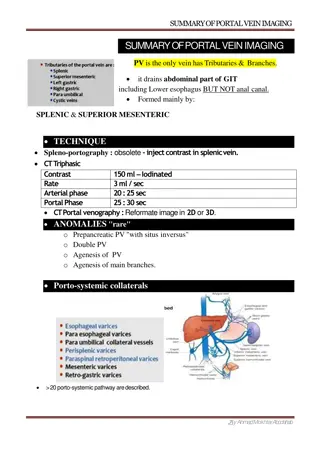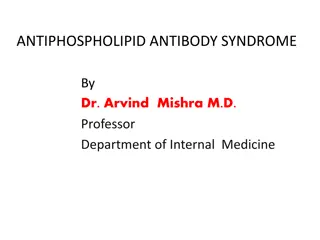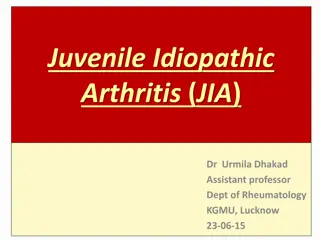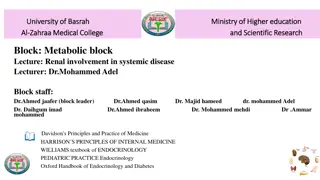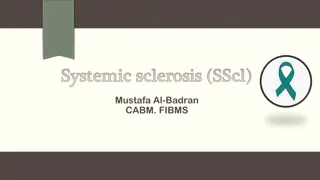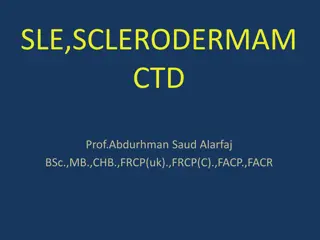
Understanding Systemic Lupus Erythematosus (SLE)
Systemic Lupus Erythematosus (SLE) is a chronic autoimmune disease that can affect various body systems, characterized by periods of remission and flares. It primarily affects females between 20-50 years of age and can manifest as skin, joint, renal, hematologic, and neurological symptoms. The etiology of SLE is unknown, but factors like genetics, hormones, environment, and medications are believed to play a role in its development. Genetic susceptibility, hormonal levels, environmental factors, and immune system alterations contribute to the pathogenesis of SLE, leading to tissue injuries and clinical manifestations that vary in severity. Discoid Lupus Erythematosus is a subtype that primarily affects the skin. Early diagnosis and management are crucial in controlling the disease progression and improving the quality of life for patients with SLE.
Download Presentation

Please find below an Image/Link to download the presentation.
The content on the website is provided AS IS for your information and personal use only. It may not be sold, licensed, or shared on other websites without obtaining consent from the author. If you encounter any issues during the download, it is possible that the publisher has removed the file from their server.
You are allowed to download the files provided on this website for personal or commercial use, subject to the condition that they are used lawfully. All files are the property of their respective owners.
The content on the website is provided AS IS for your information and personal use only. It may not be sold, licensed, or shared on other websites without obtaining consent from the author.
E N D
Presentation Transcript
SYSTEMIC LUPUS ERYTHEMATOSUS DR.APURVA AJANE (BHUTI) ASSISTANT PROFESSOR DEPT.OF PRACTICE OF MEDICINE
Definition Systemic lupus erythematosus (SLE) is a chronic multisystem autoimmune disease, which can have a wide spectrum of manifestations.
It is characterised by the presence of auto antibodies directed against various cells or their components. It is a chronic disease characterised by periods of remissions or low disease activity and disease flares.
SLE affects: Skin Joints Serous membrane Renal system Hematologic system Neurologic system
Epidemiology This is a disease that affects females between 20-50 years of age. Approx 20% of patients with systemic lupus erythematosus present by the second decade of life. Most patients with lupus have the systemic type but a small percentage have the type that affect only skin, a condition called DISCOID LUPUS ERYTHEMATOSUS .
Etiology Etiology is unknown. Most probable causes : -Genetic influence -Hormones -Environmental factors -Certain medications
Genetics & Pathogenesis Genetic susceptibility -HLA type (DR3/2),multiple immune regulatory genes complement levels. -Hormonal levels. Environmental UV exposure, microbial response (viruses like EBV, Parvovirus)drugs like phenytoin, hydralazine, methyldopa, isoniazid, infliximab.
Pathogenesis Immune system alteration Antinuclear antibodies, antibodies to ribinucleoprotein (smith antigen) Abnormalities in both B-Cells and T-Cells (overactive) Production of antibodies to self and nonself antigen.
Tissue injuries Vessel lesions & antibodies against RBC Acute necrotizing vasculitis.
Clinical features Ranges from a relatively mild disorder to rapidly progressing, affecting many body systems. Most commonly affects the skin, muscles, lining of lungs, heart, nervous tissue and kidneys. The onset of lupus is often heralded by nonspecific symptoms like : -Fever -Arthralgia -Myalgia -Fatigue.
Dermatologic Oral/nasopharyngeal ulcers. Cutaneous vascular lesions Alopecia Butterfly rash
-Photosensitivity most striking feature. -A typical butterfly rash was seen in53% of patients. -Discoid lesions over sun exposed areas which leave behind scars. -Diffuse hair loss with pillow sign. -Patchy hair loss or alopecia areata.
- Buccal or lingual ulcers and painful ulcers over the hard palate. -Diffuse macular rash over the arms with painful vasculitic lesions in the palms & soles and ears. -Lupus profundus (deeper nodular lesions with scarring, annular lesions on the trunk and arms in sub-acute cutaneous lupus and rarely psoriasiform lesions.
Alopecia Butterfly rash
Musculoskeletol Involvement :- -A polyarticular joint pain without swelling (arthralgia) is a very common symptoms. -Joint pains, swelling with early morning stiffness (arthritis). -Presence of antiphospholipid antibodies and corticosteroid used in treatment contribute to the occurence of avascular necrosis of bones. -Common sites are hip, knees, shoulder, and talus.
Cardiopulmonary Tachypnea Pleurisy Dysrythmias Accelerated CAD Pericarditis.
Renal involvement:- -Present with either as an acute nephritis or as nephrotic syndrome due to glomerular disease. -Patients present with oedema feet, puffiness of the face and in severe cases generalised anasarca. WHO type description of Lupus nephritis(1995): Class 1: Minimal mesangial lup[us nephritis. Class 2: Mesangial proliferative Class 3: Focal lupus nephritis Class 4: Diffuse lupus nephritis Class 5: Membranous lupus nephritis Class 6:Advanced sclerotic lupus.
Nervous system Generalized/focal seizures Peripheral neuropathy Cognitive dysfunction-Disorientation -memory deficits -psychiatric problems
Hematologic Anemia Leukopenia Thrombocytopenia Coagulopathy Anti-phospholipid antibody syndrome (Hypercoagulable state and life long anticoagulant therapy/recurrent venous and arterial thrombosis).
Infection Increased susceptibility to infections Fever should be considered serious Infections such as pneumonia are a common cause of death.
Diagnosis No specific test. SLE is diagnosed primarily on criteria relating to patient: -History -Physical examination -Laboratory findings.
Tissue biopsy :-Skin lesions can be biopsied and examined microscopically for signs of inflammation. ESR-to detect systemic inflammation (mostly raised) Antinuclear antibody titres:-To detect the presence of abnormal antibodies. CBC:-HB%,TLC, DLC etc to get to knoe general state of health.
Anti DNA & Anti-smith antibodies :-Increased levels suggest SLE.(ELISA-Enzyme linked immunosorbent assay). Urine analysis:-To check protein & cells, signs of possible kidney damage. X-Ray :-To see affected joints )Arthralgia). Chest X-Ray :-Pleurisy, Pleural involvement. ECG :-to determine extraarticular /cardiac involvement.
Collaborative Care Prognosis is improved with : -Earlier diagnosis -Earlier and better treatment regimens -Carefull monitoring for organ involvement. Drug therapy :NSAIDS, Antimalarial drugs, Corticosteroids/immunosppresive drugs.
Prevention No way to prevent lupus. But people who smoke may be more likely to get lupus. Avoiding smoking and perhaps other tobacco products may decrease the risk.
Homoeopathic Medicine Homoeopathic Medicine Apis Mellifica :-Apis is the important medicine in lupus or SLE where there is involvement in kidneys. There are casts in the urine. There is scanty. Burning and stinging pain while urinating is often present. Oedema of various body parts result with puffiness of eyes being a common symptom. Thirstlessness and drinks little water. Arsenic Alb :-Arsenic can be think of in SLE involvement in lungs. There is cough which is worse after midnight and on lying on back. Expectoration is white, frothy and scanty. Anxiety and restlessness.
Belladona :-SLE with fever. Skin is red, hot and flushed. There is throbbing pain in the carotid arteries. Mouth and throat are dry but still there is aversion to water. There is violent palpitation and throbbing. One can feel it in the heart and sometimes in the whole body. Sepia Calcarea carb Causticum Rhus tox Thuja.





